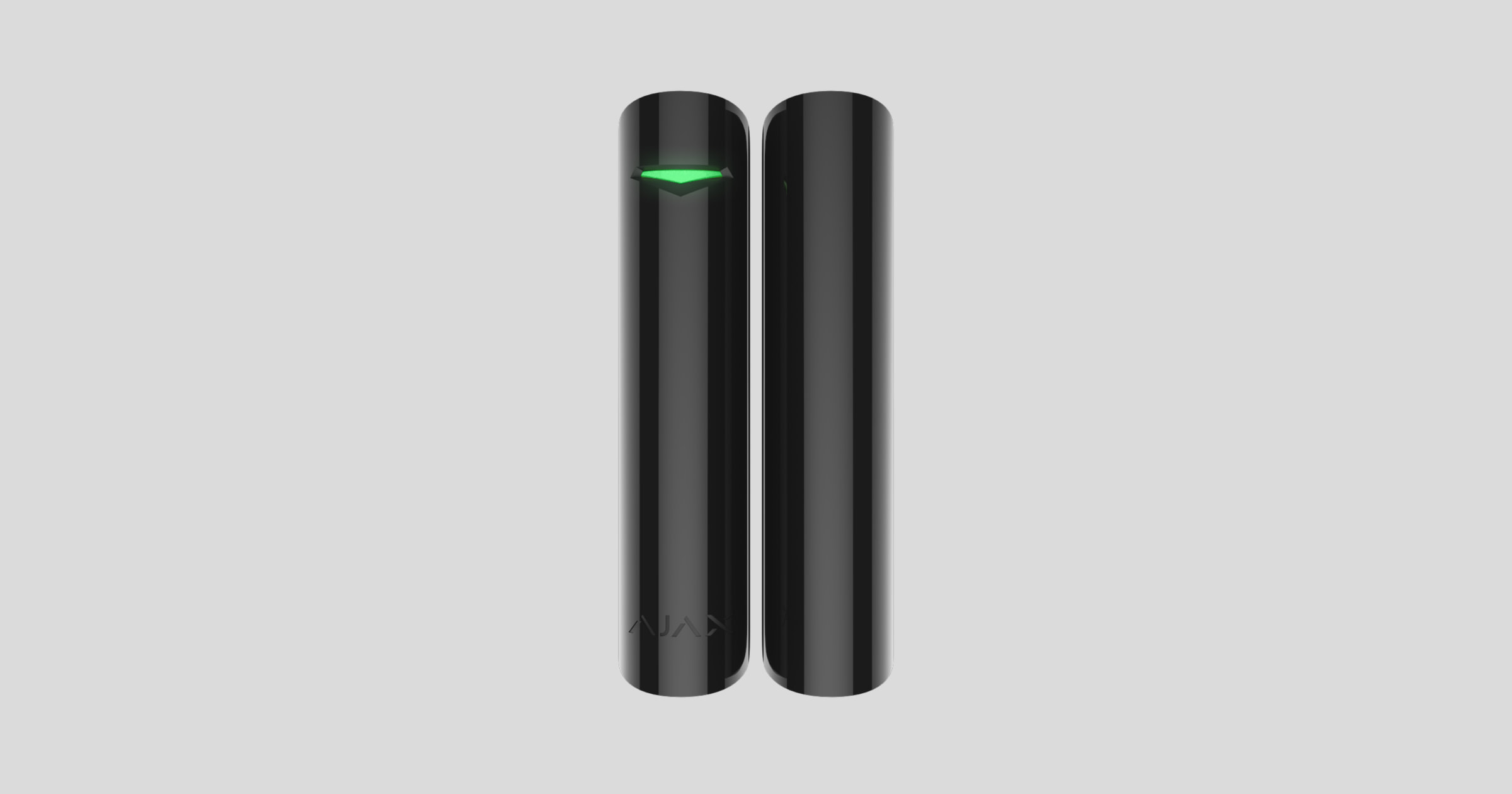DoorProtect Plus Jeweller é um detetor de abertura, impacto e inclinação sem fios. Suporta a conexão de um detetor com fios de terceiros* com um tipo de contacto normalmente fechado (NC). Para instalação interior.
O detetor não é compatível com ocBridge Plus** e módulos de integração do uartBridge**.
DoorProtect Plus Jeweller operates as part of the Ajax system by connecting to the hub via the secure Jeweller radio protocol designed to transmit alarms and events. The hub communication range is up to 1,200 meters without obstacles.
Apenas o Hub 2 Plus Jeweller e o Hub 2 (4G) Jeweller são certificados de acordo com as normas UL/ULC.
* Deve ter certificação UL.
** Não avaliado pela UL.
Elementos funcionais
- Detetor de abertura DoorProtect Plus Jeweller.
- Íman grande. Funciona a uma distância de até 2 cm do detetor e deve ser colocado à direita.
- Íman pequeno. Funciona a uma distância de até 1 cm do detetor e deve ser colocado à direita.
- Indicador LED.
- Painel de instalação SmartBracket. Para retirar o painel, faça-o deslizar para baixo.
- Parte perfurada do painel de instalação. Necessário para acionar uma sabotagem em caso de tentativa de desprender o detetor da superfície. Não o parta.
- Conector para ligar um detetor com fios de terceiros com um tipo de contacto normalmente fechado (NC).
- Código QR com o ID do dispositivo. Utilizado para a comunicação entre dispositivos do sistema Ajax.
- Botão para ligar/desligar o dispositivo.
- Botão de tamper anti-sabotagem. Alertas de tentativas de retirar o detetor da superfície ou de o retirar do painel de instalação.
Princípio do funcionamento
DoorProtect Plus Jeweller é um detetor de abertura, impacto e inclinação sem fios. Se for utilizado um método de instalação padrão, o dispositivo é composto por duas partes: a parte esquerda (detetor) contém o relé reed e o sensor de impacto e inclinação, enquanto a parte direita é o íman necessário para detetar a abertura.
Abertura é detetada por um relé reed incorporado no detetor e um íman. Quando o íman se aproxima ou se afasta, o relé reed altera o estado dos contactos e notifica a abertura/fecho. O detetor está equipado com um íman pequeno e um íman grande. O íman pequeno funciona a uma distância de até 1 cm do relé reed e o grande a uma distância de até 2 cm. Se não precisar de detetar a abertura de uma porta ou janela, pode instalar o detetor sem íman.
O sensor de impacto deteta tentativas de arrombamento de uma janela ou porta e reage à vibração quando são feitas tentativas de arrombar uma fechadura ou arrombar uma porta.
O sensor de inclinação deteta o desvio do eixo vertical de um dispositivo. Antes de o sistema ser armado, o sensor memoriza a posição inicial e é acionado se o desvio for Superior a 5°. Isto permite proteger as janelas, incluindo claraboias, e armar o sistema quando a janela está no modo de ventilação (certifique-se fazer isso desativando o detetor principal nas configurações antes).
Para que o detetor se lembre da sua posição definida, não altere o ângulo de inclinação durante um único período de hub-detetor (36 segundos por defeito) após o armamento.
Todos os sensores do detetor funcionam de forma independente. Cada sensor do detetor pode ser ativado ou desativado em apps Ajax.
Em caso de disparo, o detetor armado envia instantaneamente um alarme para o hub, que ativa as sirenes ligadas ao sistema, desencadeia cenários e notifica os utilizadores e a empresa de segurança. Todos os alarmes e eventos do detetor são registados no historial de eventos da app Ajax.
Os utilizadores sabem exatamente onde e quando é detetado um alarme. As notificações contêm a hora do alarme, o seu tipo, o nome do hub (nome do objeto protegido), o nome do dispositivo e a sala virtual à qual o detetor está atribuído.
Tecnologia de rádio Jeweller
Jeweller é um protocolo rádio para fornecer uma comunicação bidirecional rápida e fiável entre os hubs Ajax e os dispositivos ligados. O protocolo fornece alarmes instantâneos detalhados: as empresas de segurança e os utilizadores sabem exatamente qual o detetor que foi acionado, quando e onde isso aconteceu.
O Jeweller utiliza a encriptação e a autenticação para se proteger contra sabotagens e também efetua regularmente pings nos dispositivos do sistema, apresentando o seu estado em apps Ajax. O Jeweller funciona a uma distância de até 1200 m, proporcionando uma proteção fiável dos objetos e a melhor experiência de utilização para os proprietários e instaladores do sistema.
Envio de eventos para a central de monitorização
O sistema Ajax pode transmitir eventos e alarmes para a app de monitorização PRO Desktop, bem como para a central recetora de alarmes (CRA) através do Sur-Gard (Contact ID), SIA (DC-09), ADEMCO 685 e outros protocolos proprietários. Veja uma lista completa dos protocolos suportados aqui.
O DoorProtect Plus Jeweller pode transmitir os seguintes eventos:
- Alarme/recuperação do tamper do DoorProtect Plus Jeweller.
- Alarme/recuperação de um detetor com fios de terceiros ligados ao DoorProtect Plus Jeweller.
- Perda/recuperação de ligação entre o DoorProtect Plus Jeweller e o hub (ou repetidor do alcance do sinal de rádio).
- Desligar/Ligar DoorProtect Plus Jeweller.
- Tentativa sem êxito de armar o sistema de segurança (com a verificação da integridade do sistema ativada).
Quando um alarme é recebido, o operador da estação de monitorização da empresa de segurança sabe o que aconteceu e para onde enviar a equipa de resposta rápida. A possibilidade de endereçamento de cada dispositivo Ajax permite-lhe enviar não só eventos, mas também o tipo de dispositivo, o nome que lhe foi atribuído e a divisão para o PRO Desktop ou para a CRA. A lista de parâmetros transmitidos pode variar consoante o tipo de CRA e o protocolo de comunicação selecionado.
O ID e o número do dispositivo podem ser encontrados nos seus Estados na app Ajax.
Adicionar ao sistema
O hub e o dispositivo que operam em diferentes radiofrequências são incompatíveis. O alcance da frequência de rádio do dispositivo pode variar consoante a região. Recomendamos comprar e utilizar dispositivos Ajax na mesma região. Pode contactar o Suporte Técnico da Ajax para verificar as bandas de frequência de rádio na sua região.
Antes de adicionar dispositivos
- Instale a app Ajax.
- Inicie sessão na sua conta ou crie uma nova conta.
- Selecione um espaço ou crie um novo.
A funcionalidade de espaço está disponível para apps dessas versões ou superiores:
- Ajax Security System 3.0 para iOS.
- Ajax Security System 3.0 para Android.
- Ajax PRO: Tool for Engineers 2.0 para iOS.
- Ajax PRO: Tool for Engineers 2.0 para Android.
- Ajax PRO Desktop 4.0 para macOS.
- Ajax PRO Desktop 4.0 para Windows.
- Adicione pelo menos uma sala virtual.
- Adicione um hub compatível ao espaço. Certifique-se de que o hub está ligado e tem acesso à Internet através de Ethernet, Wi-Fi e/ou rede móvel.
Apenas o Hub 2 Plus Jeweller e o Hub 2 (4G) Jeweller são certificados de acordo com as normas UL/ULC.
- Certifique-se de que o espaço está desarmado e de que o hub não está a iniciar uma atualização, verificando os estados na app Ajax.
Apenas um PRO ou um administrador com direitos para configurar o sistema pode adicionar um dispositivo ao hub.
Como adicionar o DoorProtect Plus Jeweller
- Abra a app Ajax. Se a sua conta tiver acesso a mais do que um hub ou se estiver a utilizar a app PRO, selecione o hub ao qual pretende adicionar o detetor.
- Aceda ao separador Dispositivos
e clique em Adicionar Dispositivo.
- Defina o nome do detetor, leia ou escreva o código QR (localizado na carcaça e na embalagem do detetor) e selecione a divisão e o grupo (se o modo de grupo estiver ativado).
- Prima Adicionar — a contagem decrescente começará.
- Ligue o dispositivo.
Estados
Os estados apresentam informações sobre o aparelho e os seus parâmetros de funcionamento. Os estados do DoorProtect Plus Jeweller estão disponíveis em apps Ajax. Para visualizá-los:
- Inicie sessão na app Ajax.
- Selecione o hub se tiver vários ou se estiver a utilizar a app Ajax PRO.
- Aceda o separador Dispositivos
.
- Selecione DoorProtect Plus Jeweller na lista.
| Parâmetro | Valor |
| Importação de dados | Apresenta o erro aquando da transferência de dados para o novo hub:
|
| Temperatura |
Temperatura do detetor. É medido no processador do detetor e muda gradualmente. Erro aceitável entre o valor na app e a temperatura ambiente é de 2°C. O valor é atualizado assim que o detetor identifica uma alteração de temperatura de, pelo menos, 2°C. É possível configurar um cenário por temperatura para controlar dispositivos de automatização |
| Intensidade de Sinal Jeweller |
Intensidade do sinal entre o detetor e o hub (ou o repetidor) através do canal Jeweller. O valor recomendado é de 2–3 barras. O Jeweller é um protocolo para a transmissão de eventos e alarmes do DoorProtect Plus Jeweller. |
| Ligação através de Jeweller | Estado da ligação no canal Jeweller entre o dispositivo e o hub (ou o repetidor):
|
| Potência do transmissor |
Apresenta a potência selecionada do transmissor. O parâmetro aparece quando a opção Máx ou Atenuação é selecionada no menu Teste de atenuação do sinal. |
| Nome do repetidor ReX | Indica se o detetor está conectado via um repetidor de sinal de rádio. |
| Carga da Bateria |
Nível de carga da bateria do dispositivo. Apresentado em percentagem com incrementos: 0%, 10%, 20%, 30%, 50%, 75%, 100%. |
| Tampa | O estado de tamper do detetor que responde à separação do dispositivo da superfície ou à abertura do corpo:
|
| Sensor de abertura | Estado do sensor de abertura do detetor:
|
| Contacto Externo | O estado do detetor de terceiros ligado ao DoorProtect Plus Jeweller:
|
| Sensor de Impacto | Apresentado quando o sensor de impacto está ativo. |
| Sensor de Inclinação | Apresentado quando o sensor de inclinação está ativo. |
| Sempre Ativo |
Quando esta opção está ativada, o detetor está sempre armado. Isto significa que o detetor irá responder constantemente à abertura/impacto/inclinação e disparar alarmes independentemente do modo de a armar do sistema. |
| Desativação Permanente | Mostra o estado da função de desativação permanente do dispositivo:
|
| Reações a Alarmes | |
| Modo de Funcionamento | Mostra como o detetor reage aos alarmes:
|
| Atraso ao Entrar, seg. |
Tempo de atraso na entrada: de 5 a 120 segundos. O atraso de entrada (atraso de ativação do alarme) é o tempo que o utilizador tem para desarmar o sistema de segurança depois de entrar na área protegida. |
| Atraso ao Sair, seg. |
Tempo de atraso na saída: de 5 a 120 segundos. O atraso ao sair (atraso de armar) é o tempo que o utilizador tem para sair das instalações após o armar do sistema de segurança. |
| Atraso ao Entrar no Modo Noturno, seg. |
Tempo de atraso ao entrar no Modo Noturno: de 5 a 120 segundos. O atraso ao entrar (atraso de ativação do alarme) é o tempo que o utilizador tem para desarmar o sistema de segurança depois de entrar nas instalações. |
| Atraso ao Sair no Modo Noturno, seg. |
Tempo de atraso ao sair no Modo Noturno: de 5 a 120 segundos. O atraso ao sair (atraso de armar) é o tempo que o utilizador tem para sair das instalações após o armar do sistema de segurança. |
| Firmware |
Versão do firmware do dispositivo. |
| ID do dispositivo |
ID do detetor. Utilizado para adicionar um detetor ao hub. Também disponível no código QR na carcaça do dispositivo e na sua caixa de embalagem. |
| Número do Dispositivo. | Número do bucle (zona) do dispositivo. |
* Deve ter certificação UL.
Definições
Para alterar as definições do detetor na app Ajax:
- Selecione o hub se tiver vários ou se estiver a utilizar a app Ajax PRO.
- Aceda o separador Dispositivos
.
- Selecione DoorProtect Plus Jeweller na lista.
- Aceda a Definições clicando no ícone de engrenagem
.
- Defina os parâmetros.
- Clique Voltar duas vezes para guardar as definições.
| Configuração | Valor |
| Nome |
Nome do detetor. Apresentado na lista de dispositivos do hub, texto SMS e notificações no historial de eventos. Para alterar o nome do detetor, toque no campo de introdução. O nome pode conter até 12 caracteres cirílicos ou até 24 caracteres latinos. |
| Sala |
Seleção da sala virtual à qual o DoorProtect Plus Jeweller está atribuído. O nome da sala aparece no texto do SMS e nas notificações no historial de eventos. |
| Indicação LED de alarme |
Quando a opção está desativada, o indicador LED do detetor não informa sobre alarmes e acionamentos de tamper. Disponível para dispositivos com a versão de firmware 5.55.0.0 e superior. Como encontrar a versão do firmware ou o ID do detetor ou dispositivo? |
| Sensor de abertura | Quando a opção está ativada, o sensor de abertura DoorProtect Plus Jeweller responde à abertura e ao fecho. |
|
Contacto Externo * |
Quando a opção está ativada, o DoorProtect Plus Jeweller regista os alarmes de um detetor com fios de terceiros ligado a ele. |
| Sempre Ativo |
Quando esta opção está ativada, o detetor está sempre armado. Isto significa que o detetor irá responder constantemente à abertura/impacto/inclinação e disparar alarmes independentemente do modo de a armar do sistema. |
| Tipo de Contacto Externo | Selecione o tipo de um detetor com fios de terceiros ligado aos terminais do DoorProtect Plus Jeweller:
A opção está disponível para detetores com a versão de firmware 5.53.1.0 e superior. Saiba mais sobre a ligação do detetor de movimento da persiana |
| Tempo Antes do Alarme, seg |
O tempo pelo qual o número de impulsos especificado deve ser contado: 5 a 30 segundos. Contado após o primeiro impulso do detetor de persianas ligado ao DoorProtect Plus Jeweller. Esta definição é exibida se o tipo de contacto externo for Persiana. |
| Impulsos Antes do Alarme |
Número de impulsos do detetor de persianas ligado ao DoorProtect Plus Jeweller, que é necessário para acionar um alarme: 2 a 7. Esta definição é exibida se o tipo de contacto externo for Persiana. |
| Sensor de Impacto | Quando esta opção está ativada, o detetor deteta impactos. |
| Sensibilidade | Nível de sensibilidade do sensor de impacto. A escolha depende do tipo de objeto, da presença de fontes prováveis de falsos alarmes e das especificidades da área protegida:
Antes de selecionar o nível de sensibilidade, faça o teste da zona de deteção. Se o detetor não reagir ao impacto em 5 de 5 tentativas durante o teste, aumente a sensibilidade. |
| Ignorar o Simples Impacto | Quando esta opção está ativada, o alarme só é ativado se o sensor detetar mais do que um impacto. |
| Sensor de Inclinação | Quando esta opção está ativada, o detetor deteta uma alteração no ângulo de inclinação. |
| Inclinação | Seleção do valor inicial do ângulo de inclinação do detetor. O sensor deteta um alarme se o valor do ângulo de inclinação se alterar. |
| Atraso do Alarme de Inclinação | O tempo desde o momento em que o detetor é inclinado até ao alarme: 1 segundo a 1 minuto. |
| Alerta com uma sirene se for detetada uma abertura | Se esta opção estiver ativada: as sirenes do sistema de segurança são ativadas quando o DoorProtect Plus Jeweller deteta uma abertura. |
| Alerta com uma sirene se um contacto externo estiver aberto |
Se esta opção estiver ativada: as sirenes do sistema de segurança são ativadas quando um detetor de terceiros ligado ao DoorProtect Plus Jeweller deteta um alarme. Esta definição é apresentada se o tipo de contacto externo for Contacto externo. |
| Alerta com uma sirene se a persiana for acionada |
Se esta opção estiver ativada: as sirenes do sistema de segurança são ativadas quando a persiana ligada ao DoorProtect Plus Jeweller deteta um alarme. Esta definição é exibida se o tipo de contacto externo for Persiana. |
| Alerta com sirene em caso de desativação da persiana |
Se esta opção estiver ativada: sirenes do sistema de segurança são ativadas quando o detetor de persiana conectado à DoorProtect Plus Jeweller está desativado. Esta definição é exibida se o tipo de contacto externo for Persiana. |
| Alerta com uma sirene se for detetado um impacto | Se esta opção estiver ativada: as sirenes do sistema de segurança são ativadas quando o DoorProtect Plus Jeweller deteta um impacto. |
| Alerta com uma sirene em caso de deteção de movimento | Se esta opção estiver ativada: as sirenes do sistema de segurança são ativadas quando o DoorProtect Plus Jeweller deteta uma inclinação. |
| Definições de Chime |
Abre as Definições de Chime. |
| Reações a Alarmes | |
| Modo de Funcionamento | Especifique como este dispositivo irá reagir aos alarmes:
|
| Atraso ao Entrar, seg. |
Tempo de atraso na entrada: de 5 a 120 segundos. O atraso de entrada (atraso de ativação do alarme) é o tempo que o utilizador tem para desarmar o sistema de segurança depois de entrar na área protegida. |
| Atraso ao Sair, seg. |
Tempo de atraso na saída: de 5 a 120 segundos. O atraso ao sair (atraso de armar) é o tempo que o utilizador tem para sair das instalações após o armar do sistema de segurança. |
| Armar no Modo Noturno |
Se estiver ativa, o detetor passa para o modo armado quando o Modo Noturno está ativado. |
| Atraso ao Entrar no Modo Noturno, seg. |
Tempo de atraso ao entrar no Modo Noturno: de 5 a 120 segundos. O atraso ao entrar (atraso de ativação do alarme) é o tempo que o utilizador tem para desarmar o sistema de segurança depois de entrar nas instalações. |
| Atraso ao Sair no Modo Noturno, seg. |
Tempo de atraso ao sair no Modo Noturno: de 5 a 120 segundos. O atraso ao sair (atraso de armar) é o tempo que o utilizador tem para sair das instalações após o armar do sistema de segurança. |
| Teste de Intensidade de Sinal Jeweller |
Passa o dispositivo para o modo de teste de intensidade do sinal do Jeweller. Para determinar o local de instalação ideal para o dispositivo, o teste permite-lhe verificar a intensidade do sinal de comunicação entre o detetor e o hub (ou o repetidor) através do protocolo de transferência de dados sem fios Jeweller. O valor recomendado é de 2–3 barras. |
| Teste da Zona de Deteção |
Passa o detetor para o modo de teste da zona de deteção. O teste verifica como o detetor reage à abertura/impacto/inclinação e determina o local de instalação ideal. Para verificar o sensor de inclinação e de impacto antes de iniciar o teste, ative estes sensores nas definições do detetor. Se o detetor não reagir à abertura/impacto/inclinação em 5 casos de 5 durante o teste, aumente a sensibilidade do detetor. |
| Teste de Atenuação do Sinal |
Passa o dispositivo para o modo de teste de atenuação do sinal. Durante o teste, a potência do transmissor de rádio é reduzida ou aumentada para simular uma mudança na situação do objeto e verificar a estabilidade da comunicação entre o detetor e o hub (ou o repetidor do sinal de rádio). |
| Guia do Utilizador | Abre o Manual do Utilizador do DoorProtect Plus Jeweller na app Ajax. |
| Desativação Permanente | Permite ao utilizador desativar o dispositivo sem o retirar do sistema. Existem três opções:
Também é possível configurar separadamente a desativação do dispositivo:
A funcionalidade é configurada na app Ajax PRO. |
| Desemparelhar Dispositivo | Desemparelha o dispositivo, desliga-o do hub e elimina as suas definições. |
* Deve ter certificação UL.
Como definir o Chime
Notificações de abertura — um sinal sonoro que indica o acionamento dos detetores de abertura quando o sistema é desarmado. A funcionalidade é utilizada, por exemplo, em lojas, para notificar os empregados de que alguém entrou no edifício.
A ativação do Chime é feita em duas fases: ativação dos detetores de abertura e ativação das sirenes.
Definições dos detetores
- Aceda ao menu Dispositivos
.
- Selecione o detetor DoorProtect Plus Jeweller.
- Aceda às suas definições clicando no ícone de engrenagem
no canto Superior direito.
- Aceder ao menu Definições do Chime.
- Selecione os eventos sobre os quais a sirene deve notificar:
- Se for detetada uma abertura.
- Se um contacto externo for aberto (disponível se a opção Contacto externo estiver ativada).
- Selecione o Som de Chime: 1 a 4 bips curtos. Uma vez selecionado, a app Ajax reproduzirá o som.
- Clique Voltar para guardar as definições.
- Configure a sirene.
Indicação LED
O indicador LED DoorProtect Plus Jeweller pode notificar a verde quando o detetor é acionado e sobre os seus outros estados.
| Indicação LED | Evento | Nota |
| Acende-se durante alguns segundos. | Ligação do detetor ao hub. | |
| Acende-se a verde durante 1 segundo. | Alarme em caso de abertura, impacto, inclinação ou ativação de tamper. | O detetor regista o movimento uma vez a cada 5 segundos. |
| Em caso de alarme, acende-se lentamente a verde e apaga-se lentamente. | As baterias do detetor têm de ser substituídas. | O procedimento para substituir as baterias é descrito no artigo Como substituir as baterias no detetor DoorProtect Plus Jeweller. |
Teste de funcionalidade
O sistema Ajax dispõe de vários testes para escolher o local de instalação correto para os dispositivos. Os testes do DoorProtect Plus Jeweller não começam imediatamente, mas começam o mais tardar após um único período de ping do detetor de hub (36 segundos por predefinição). Pode alterar o período de ping dos dispositivos no menu Jeweller das definições do hub.
Para executar um teste, na app Ajax:
- Selecionar o hub pretendido.
- Aceda o menu Dispositivos
.
- Selecione DoorProtect Plus Jeweller.
- Aceda às Definições
.
- Escolha um teste:
- Execute o teste.
Colocação
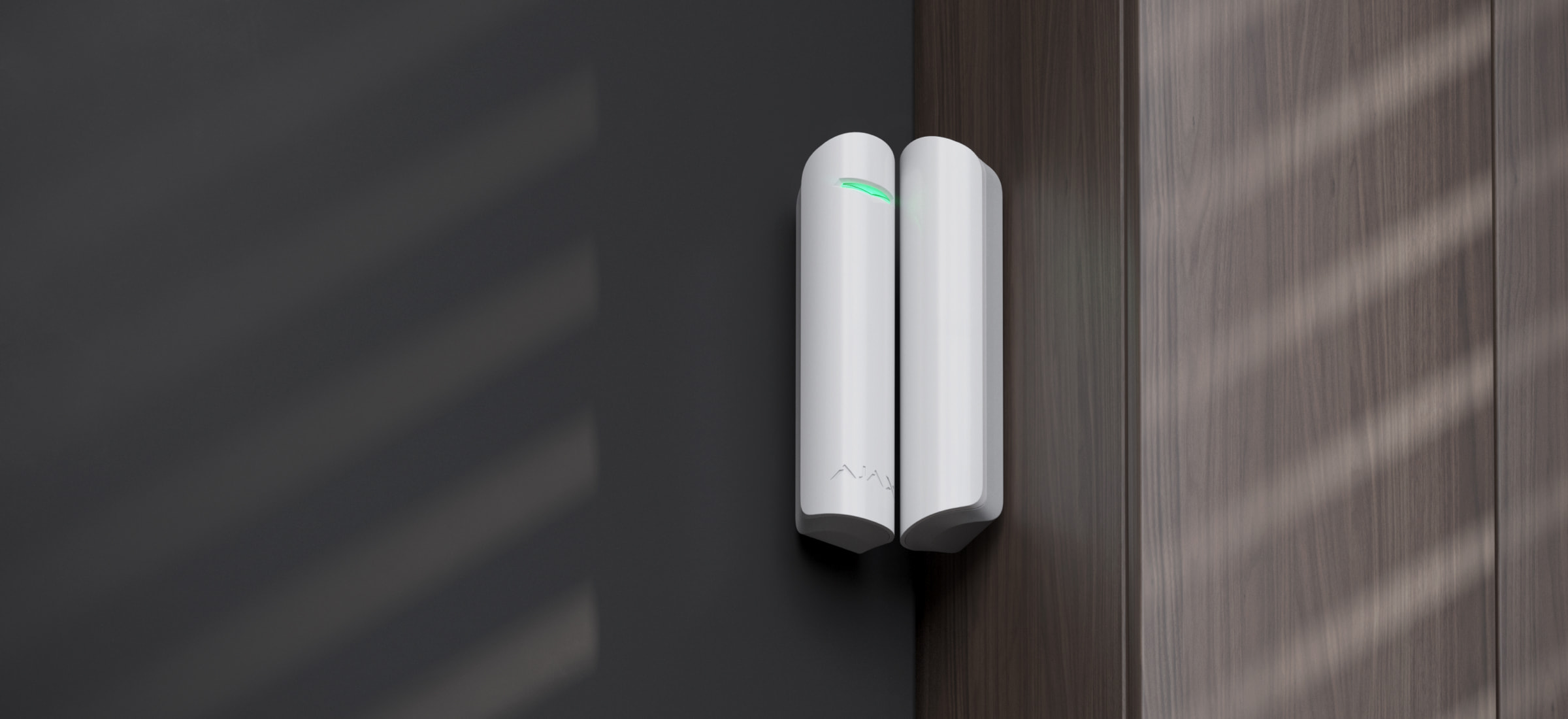
O dispositivo destina-se apenas a uso em interiores.
Considere as recomendações de colocação ao desenvolver um projeto para o sistema de segurança da instalação. O sistema de segurança deve ser concebido e instalado por especialistas. A lista de parceiros Ajax autorizados está disponível aqui.
Ao escolher um local para o dispositivo, considere os parâmetros que afetam o seu funcionamento:
- Zona de deteção.
- Intensidade de Sinal Jeweller.
- Distância entre o detetor e o hub.
- Presença de obstáculos à passagem do sinal de rádio: paredes, tetos entre pisos, objetos de grandes dimensões localizados na sala.
Conselhos para a instalação
Para a deteção de aberturas, recomenda-se que o íman seja colocado na parte móvel e o detetor no caixilho da porta ou da janela.
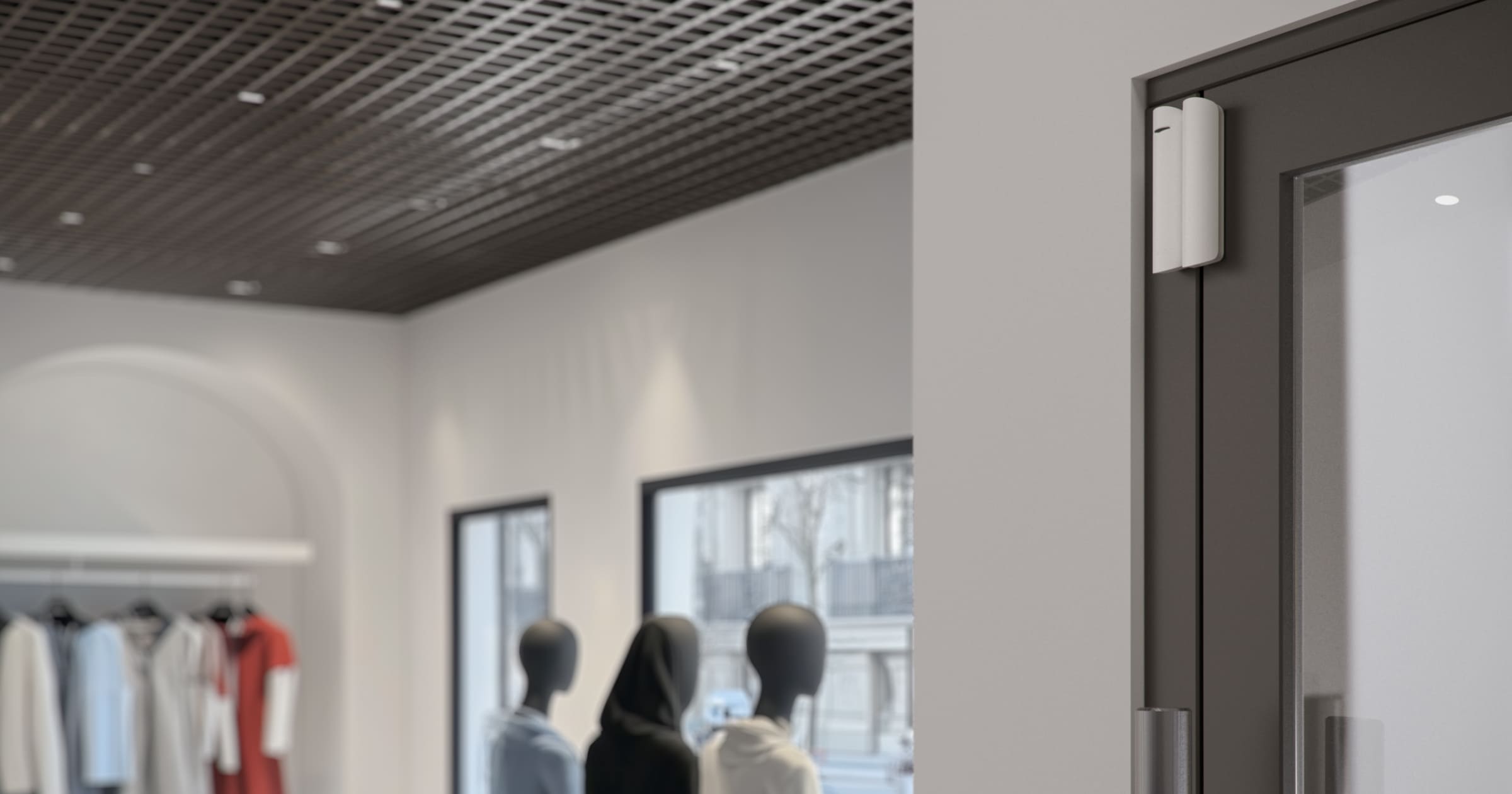
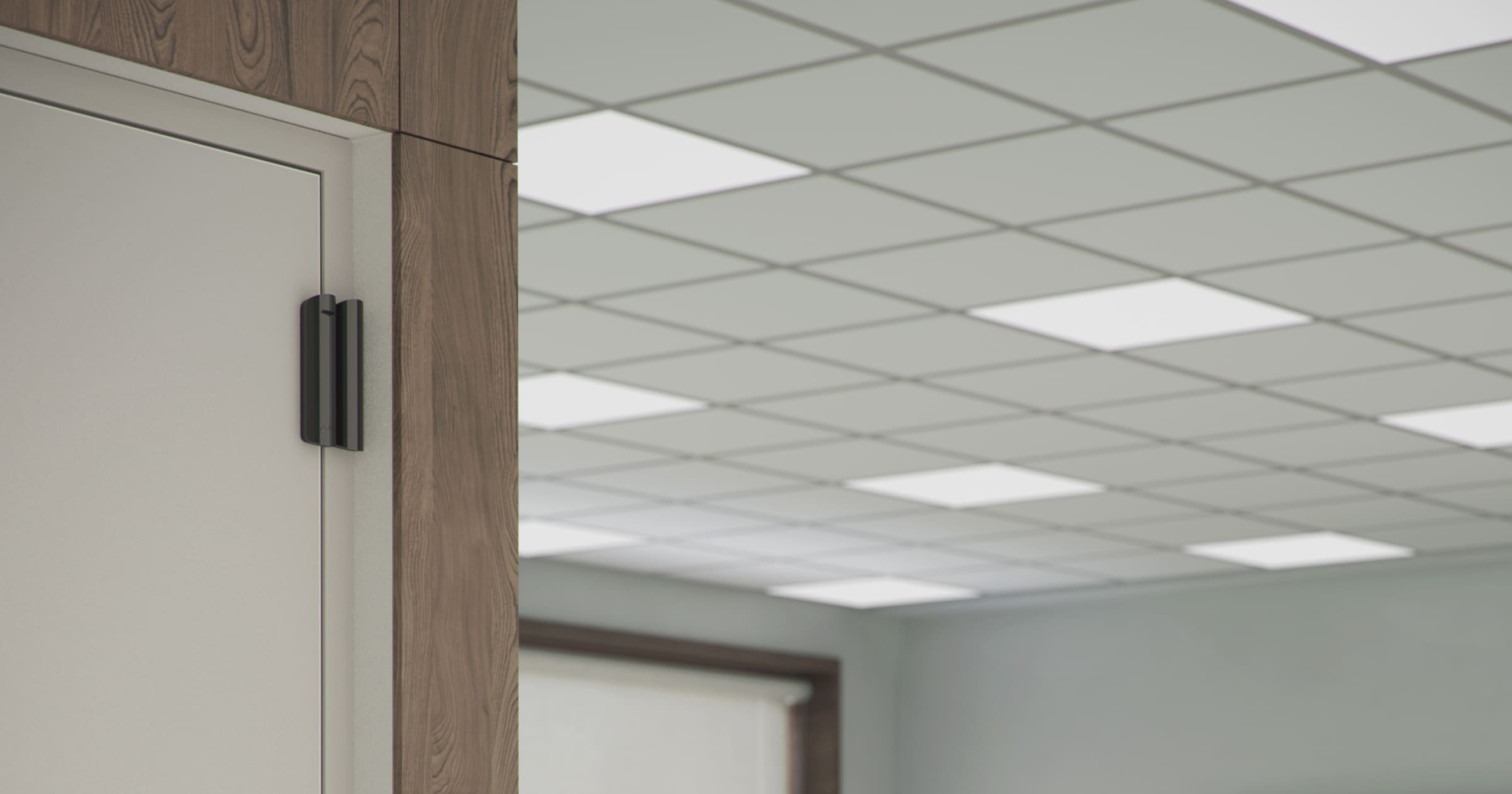
O detetor deve ser colocado numa parte móvel para que o DoorProtect Plus Jeweller possa detetar impactos e inclinações.
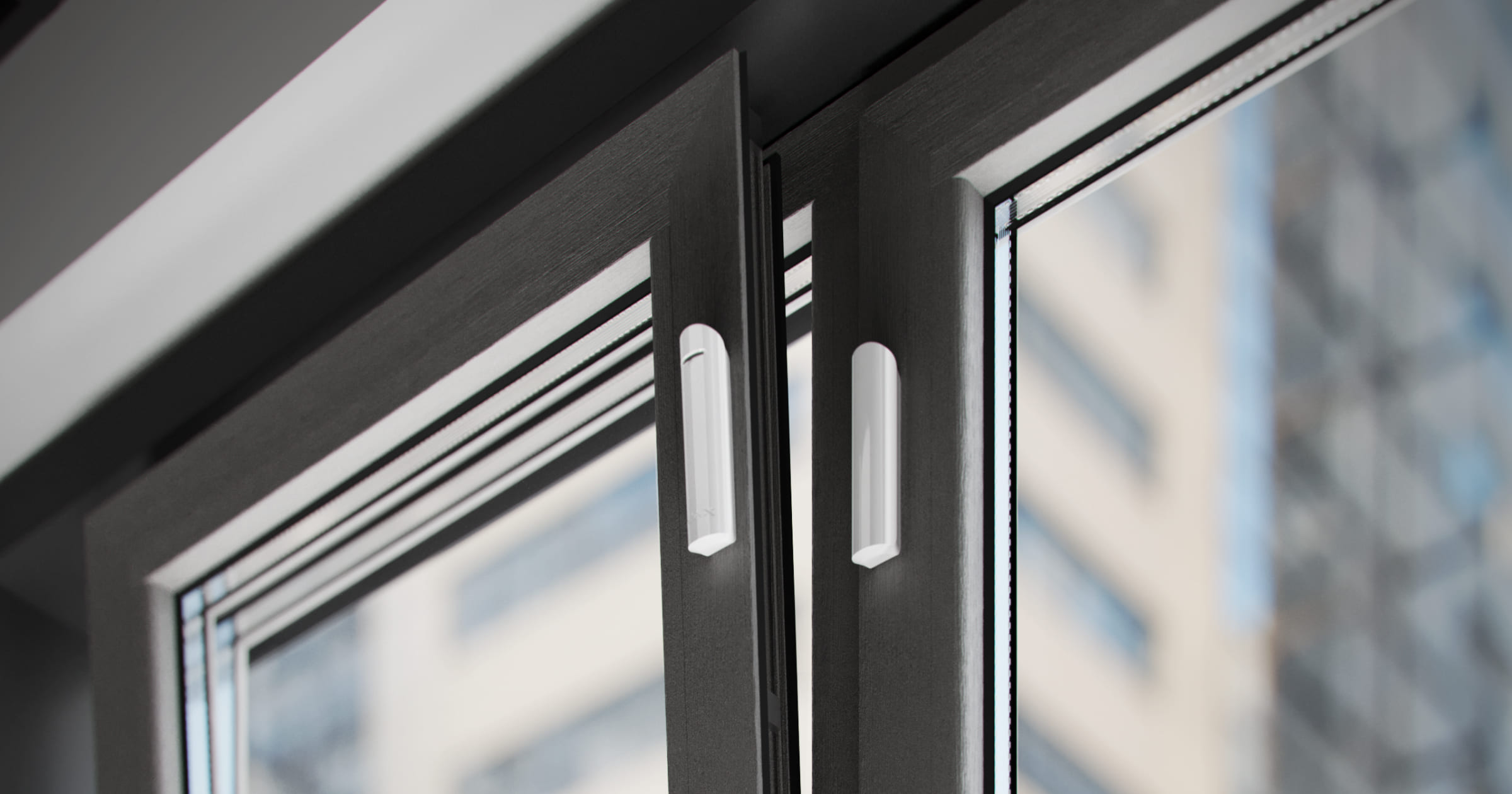
O DoorProtect Plus Jeweller pode ser instalado em janelas, incluindo clarabóias, e arma o sistema quando a janela está no modo de ventilação (certifique-se de que desativa o sensor magnético nas definições antes de o fazer).
Colocação do íman relativamente ao detetor
O íman deve ser instalado em paralelo com a carcaça do detetor.
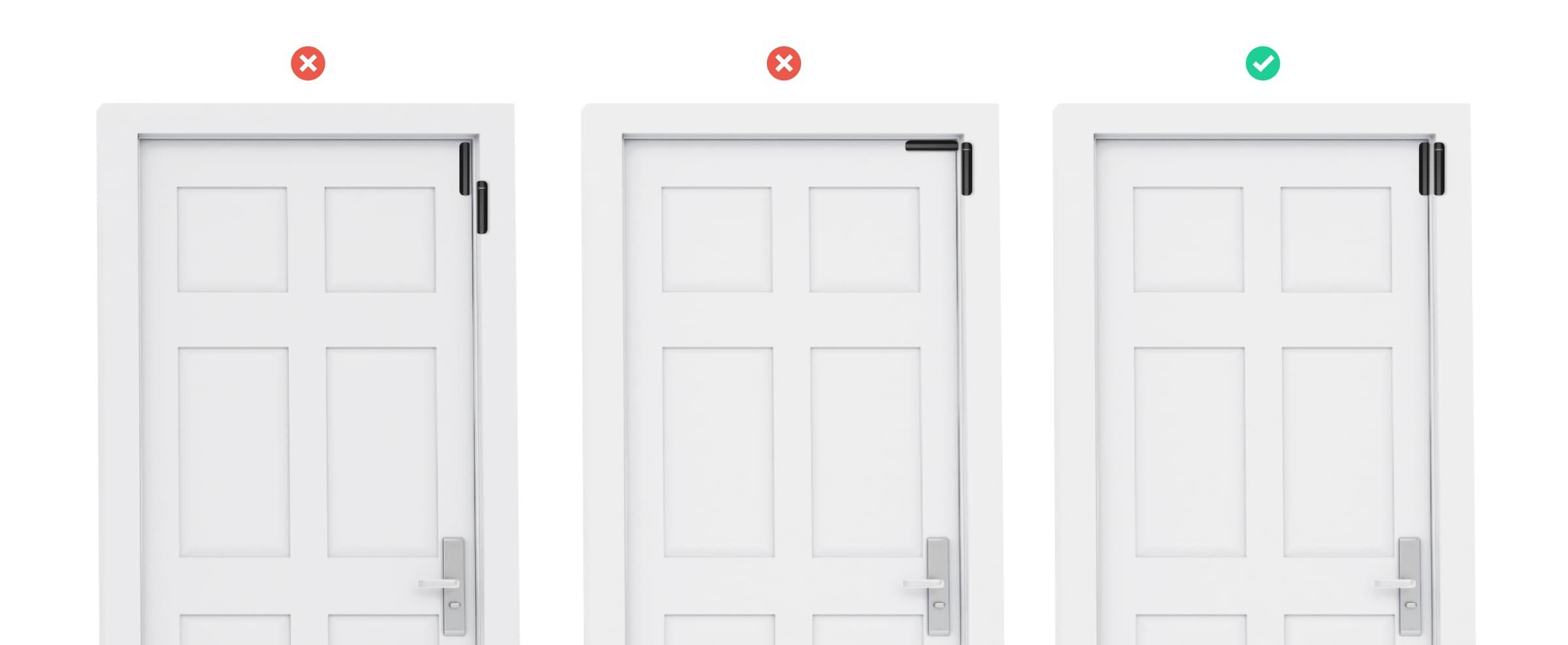
Para montar o detetor em planos perpendiculares, utilize um pequeno íman. A distância entre o íman e o detetor não deve ser Superior a 1 cm.
Se as peças do DoorProtect Plus Jeweller estiverem montadas no mesmo plano, utilize um íman grande. A distância entre o íman e o detetor não deve ser Superior a 2 cm.
O íman está fixado à direita do detetor. O lado em que o íman está fixado está assinalado com uma seta na carcaça do detetor.
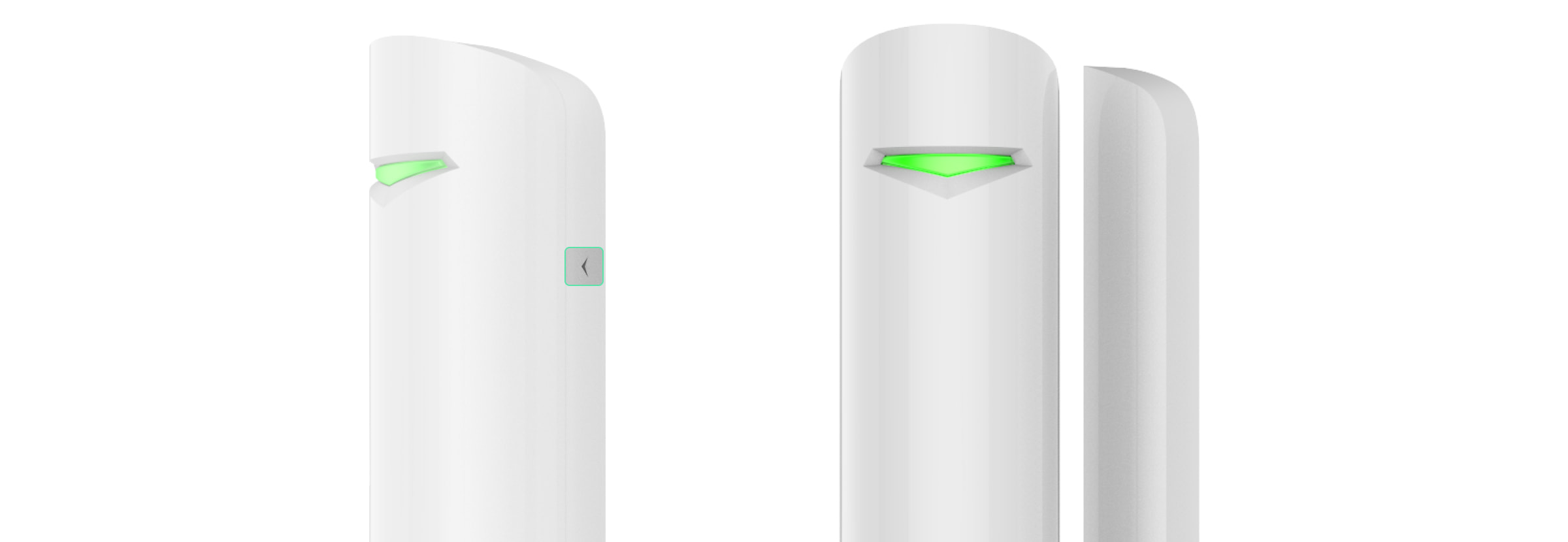
Se não houver necessidade de detetar a abertura, o íman não é instalado. Neste caso, é necessário desativar o sensor de abertura nas definições do detetor nas apps Ajax.

Se necessário, o detetor pode ser posicionado horizontalmente. Não instale o detetor com o indicador LED virado para baixo, pois isso pode provocar a sua queda e avaria devido a danos.
Não instale o detetor no lado da dobradiça da janela ou da porta — pode não responder à abertura.
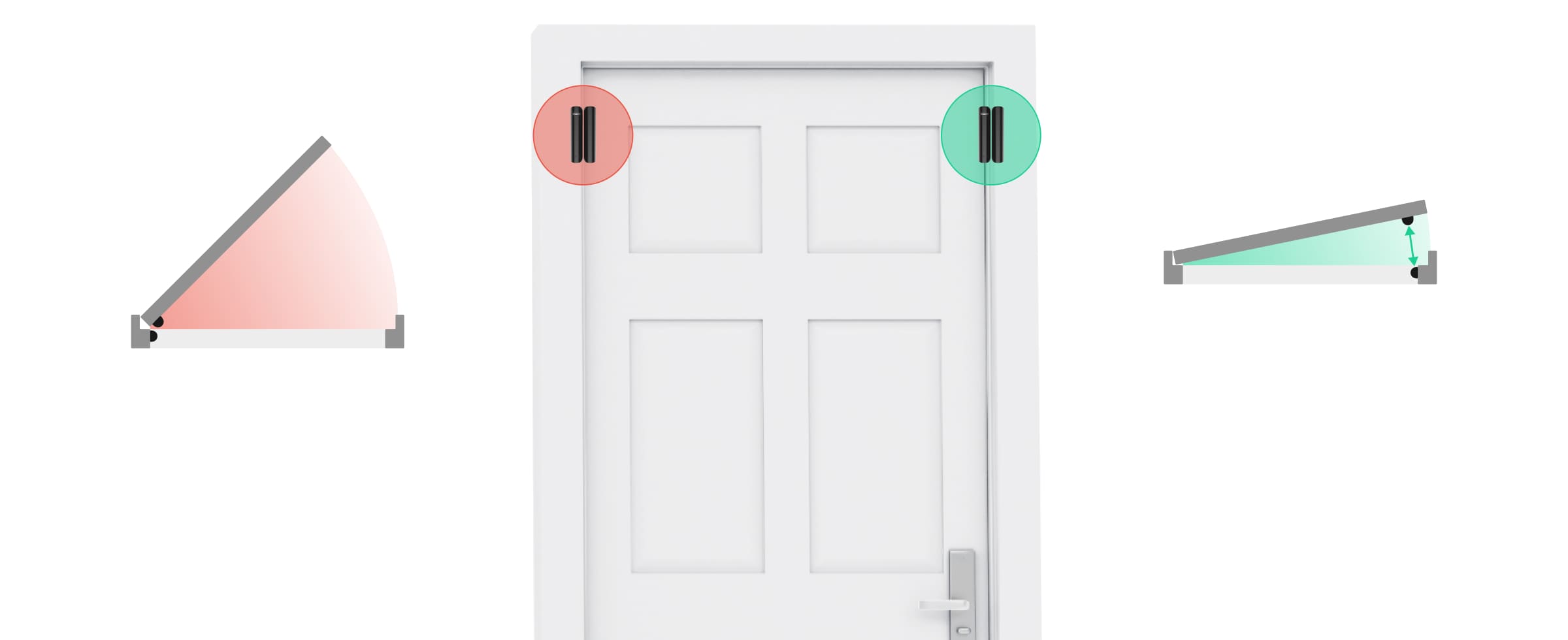
Intensidade do sinal
A intensidade do sinal Jeweller é determinada pelo número de pacotes de dados não entregues ou corrompidos trocados entre o hub e o detetor num determinado período de tempo. A intensidade do sinal é indicada pelo ícone no separador Dispositivos
:
- Três barras— excelente intensidade de sinal.
- Duas barras— boa intensidade de sinal.
- Uma barra— fraca intensidade de sinal, não é garantido um funcionamento estável.
- Ícone riscado— sem sinal.
Verifique a intensidade do sinal do Jeweller no local de instalação. Se a intensidade do sinal for baixa (uma única barra) ou nula, não podemos garantir o funcionamento estável do sistema de segurança. Considere a possibilidade de mudar o dispositivo de sítio, uma vez que um reposicionamento, mesmo de 20 cm, pode melhorar significativamente a intensidade do sinal. Se o detetor continuar a ter um nível de sinal baixo ou instável depois de se deslocar, utilize um repetidor do sinal de rádio.
Zona de deteção
Tenha em conta a área de funcionamento do íman ao escolher o local de instalação. Os ímanes mais pequenos atuam a distâncias até 1 cm do relé reed, enquanto os maiores atuam a distâncias até 2 cm.
Quando instalar o detetor, faça o Teste da Zona de Deteção. Isto permite-lhe verificar o funcionamento do dispositivo e determinar com precisão o sector em que o detetor reage ao movimento.
Não instale o detetor:
- No exterior. Isto pode dar origem a falsos alarmes e danificar o detetor.
- No interior de estruturas metálicas. Isto pode resultar na perda do sinal de rádio.
- Espelhos próximos. Isto pode resultar na blindagem ou atenuação do sinal de rádio.
- Em compartimentos com temperatura e humidade fora da gama de funcionamento permitida. Isto pode danificar o detetor.
Instalação do detetor
Antes de instalar o DoorProtect Plus Jeweller, certifique-se de que selecionou o local ideal e que este cumpre os requisitos deste manual.
Para instalar o detetor:
- Retire o painel de instalação SmartBracket do lado esquerdo do detetor, empurrando-o e puxando-o suavemente para baixo.
- Se estiver a utilizar um íman grande, retire o painel de instalação SmartBracket empurrando-o e puxando-o ligeiramente para baixo, como indicado no passo anterior. Se estiver a utilizar um íman pequeno, desmonte a sua carcaça levantando a parte de trás com um objeto plano. Para isso, utilize uma chave de fendas.
Se não houver necessidade de detetar a abertura, o íman não é instalado.
- Fixe o painel de instalação SmartBracket à superfície do caixilho da porta ou janela utilizando fita adesiva de dupla face ou outros fixadores temporários.
Utilize fita adesiva de dupla face apenas para fixação temporária, uma vez que o dispositivo pode sair da superfície em qualquer altura e ficar danificado se cair. Desde que o dispositivo esteja colado com fita adesiva, o tamper não será acionado quando o dispositivo for separado da superfície.
- Monte o detetor e o íman (se utilizado) no painel de instalação. Quando o detetor estiver fixo no SmartBracket, o LED do dispositivo piscará, sinalizando que o tamper do detetor está fechado.
- Efetue o Teste de intensidade do sinal Jeweller. A intensidade de sinal recomendada é de duas ou três barras. Se a intensidade do sinal for baixa (uma única barra) ou nula, não podemos garantir o funcionamento estável do sistema de segurança. Considere a possibilidade de mudar o dispositivo de sítio, uma vez que um reposicionamento, mesmo de 20 cm, pode melhorar significativamente a intensidade do sinal. Se o detetor continuar a ter uma intensidade de sinal baixa ou instável após a recolocação, utilize um repetidor do sinal de rádio.
- Faça o Teste da zona de deteção:
- Faça um teste para verificar o sensor de abertura. Abra/feche a porta ou a janela e monitorize a reação do LED: este deve piscar sempre que a porta/janela é aberta ou fechada. Se o detetor não reagir à abertura em 5 de 5 tentativas durante o teste, reduza a distância entre o detetor e o íman.
- Para verificar o sensor de inclinação e de impacto, ative estes sensores nas definições do detetor antes de iniciar o teste. Retire o lado esquerdo do detetor do painel de instalação e coloque-o numa superfície plana. Execute o teste. Para testar o sensor de inclinação, levante o detetor da superfície e incline-o verticalmente. Para testar o sensor de impacto, simule um impacto na superfície em que o detetor está colocado. Monitorize a reação do LED: deve piscar a cada inclinação e impacto registados.
- Fixe os painéis do SmartBracket e a parte de trás do íman pequeno (se utilizado) com os parafusos fornecidos, utilizando todos os pontos de fixação. Se utilizar outros elementos de fixação, certifique-se de que não danificam ou deformam o painel de instalação.
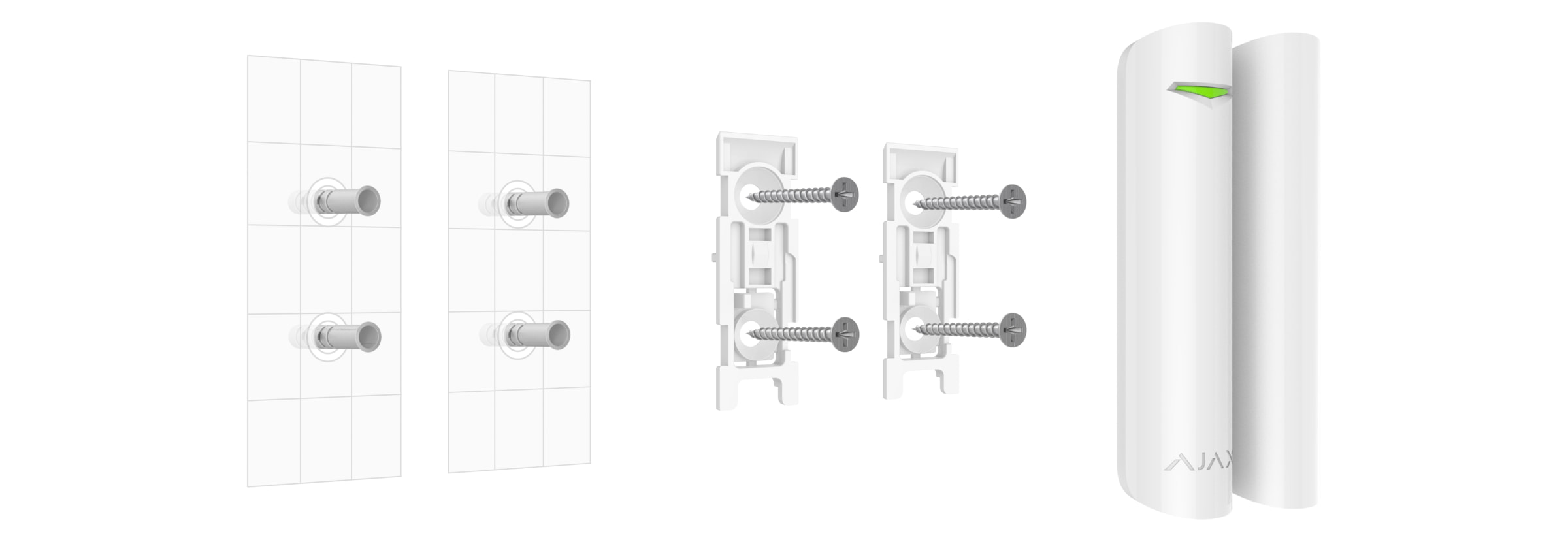
- Aperte o detetor e o íman nos painéis de instalação.
Ligação de um detetor com fios de terceiros *
Ligação de um detetor com fios de terceiros *
É possível ligar um detetor com fio com tipo de contacto NC (normalmente fechado) ao DoorProtect Plus Jeweller. Pode ser um detetor de movimento, de abertura ou de vibração.
O DoorProtect Plus Jeweller não alimenta o detetor de terceiros. O detetor deve ser ligado separadamente. Para saber o tipo e a tensão de entrada do detetor de terceiros, consulte a documentação do dispositivo ou contacte o apoio técnico do fabricante.
Instale o detetor de terceiros a uma distância não Superior a 1 metro (utilizando o cabo de sinal 4 × 0,22, condutor de cobre) do DoorProtect Plus Jeweller. O aumento do comprimento do fio diminui a qualidade da comunicação entre os dispositivos.
Como conectar um detetor com fios de terceiros:
- Retire o detetor do painel de instalação, se já estiver instalado.
- Separe cuidadosamente as fichas da carcaça do detetor para a saída dos fios.
- Encaminhe o cabo do detetor com fios de terceiros para a carcaça do DoorProtect Plus Jeweller.
- Ligue o detetor com fios aos terminais do DoorProtect Plus Jeweller.
- Nas definições do DoorProtect Plus Jeweller, ative a opção Contacto externo.
- Verifique o funcionamento do detetor com fios conectado.
Para receber um alarme quando as persianas se abrem, ligue um detetor de movimento de persianas com fio com um contacto normalmente fechado ao DoorProtect Plus Jeweller. A opção está disponível para detetores com a versão de firmware 5.53.1.0 e superior.
* Deve ter certificação UL.
Manutenção
Verifique regularmente o funcionamento do detetor. A frequência ideal dos controlos é de três em três meses. Limpe a carcaça do dispositivo do pó, teias de aranha e outros contaminantes à medida que vão surgindo. Utilize um pano seco e macio adequado para a manutenção do equipamento.
Não utilize quaisquer substâncias que contenham álcool, acetona, gasolina e outros solventes ativos para limpar o detetor.
A duração calculada da bateria do detetor será de até 5 anos a partir de uma bateria incorporada à taxa de 10 aberturas/fechamentos por dia com as definições padrão Jeweller ou Jeweller/Fibra. Quando as baterias do detetor estiverem descarregadas, o sistema de segurança enviará uma notificação adequada para as apps Ajax e o LED acender-se-á e apagar-se-á gradualmente quando o detetor emitir um alarme.
Recomendamos que substitua as baterias imediatamente após a notificação. É aconselhável utilizar baterias de lítio. Têm uma grande capacidade e são menos afetadas pelas temperaturas.
Especificações técnicas
Garantia
A garantia dos produtos da empresa de responsabilidade limitada “Ajax Systems Manufacturing” é válida durante 2 anos após a compra.
Se o dispositivo não funcionar corretamente, contacte primeiro o Apoio Técnico Ajax. Em maioria dos casos, os problemas técnicos podem ser resolvidos remotamente.
Contactar o Suporte Técnico:
